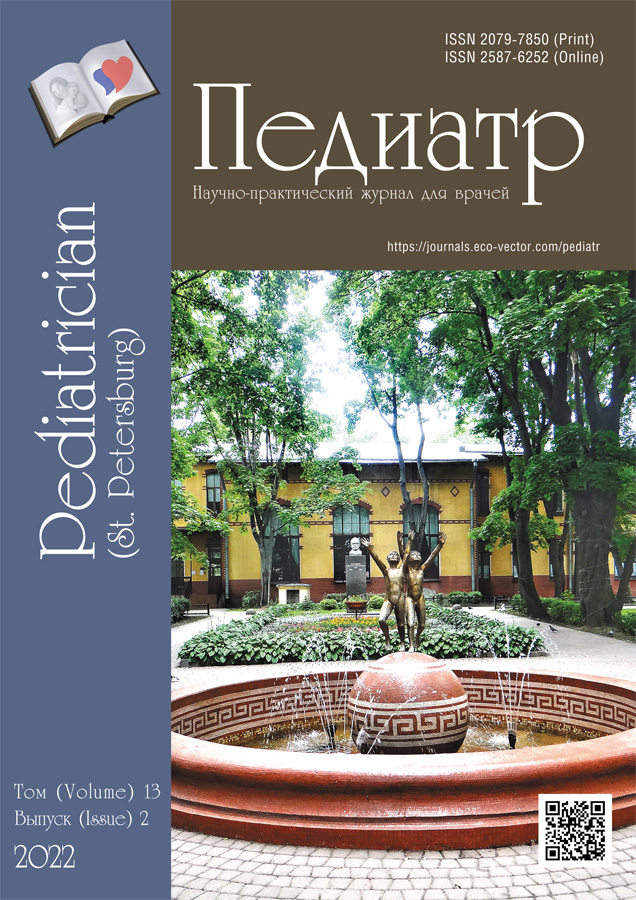葡萄球菌烫伤样皮肤综合征临床病例
- 作者: Milyavskaya I.R.1, Revnova M.O.1, Leina L.M.1, Felker E.Y.1, Mineeva O.K.1, Bolshakova E.S.1
-
隶属关系:
- St. Petersburg State Pediatric Medical University
- 期: 卷 13, 编号 2 (2022)
- 页面: 99-107
- 栏目: Clinical observation
- URL: https://journals.eco-vector.com/pediatr/article/view/109262
- DOI: https://doi.org/10.17816/PED13299-107
- ID: 109262
如何引用文章
详细
“葡萄球菌烫伤样皮肤综合征(staphylococcal scalded skin syndrome, SSSS)是是发生在新生儿的一种严重的急性泛发性剥脱型脓疱病。这种疾病是由金黄色葡萄球菌产生的一种表皮剥脱毒素引起的,该毒素裂解表皮颗粒层的桥粒芯糖蛋白-1,导致表面脓疱疮形成。鉴别诊断是按中毒性表皮坏死松解症(TEN或Lyell综合征)的病状进行的。TEN主要是药物引起,包括磺胺类、抗痉挛药、抗生素等。为了说明鉴别诊断的困难,我们引用我们对一名一岁女孩的临床观察。病情较为严重的女孩一入院就送入抢救室去,诊断为Lyell综合征。入院时,观察到广泛的皮肤病变,即多个松弛性水疱和表皮松解。同时,粘膜没有受到影响。女孩被诊断为葡萄球菌烫伤样皮肤综合征。因此,SSSS和TEN的鉴别诊断是困难的。诊断时应考虑病史、临床表现,特别注意黏膜病变。
全文:
作者简介
Irina R. Milyavskaya
St. Petersburg State Pediatric Medical University
Email: imilyavskaya@yandex.ru
MD, PhD, Associate Professor Department of Dermatovenerology
俄罗斯联邦, Saint PetersburgMaria O. Revnova
St. Petersburg State Pediatric Medical University
Email: revnoff@mail.ru
MD, PhD, Dr. Med. Sci., Professor, Head of the A.F. Tur Department of Pediatrics
俄罗斯联邦, Saint PetersburgLarisa M. Leina
St. Petersburg State Pediatric Medical University
Email: larisa.leina@mail.ru
MD, PhD, Associate Professor Department of Dermatovenerology
俄罗斯联邦, Saint PetersburgEvgeny Yu. Felker
St. Petersburg State Pediatric Medical University
Email: felkeru@gmail.com
MD, PhD, Head of the Department of Anesthesiology and Intensive Care
俄罗斯联邦, Saint PetersburgOlga K. Mineeva
St. Petersburg State Pediatric Medical University
Email: o-mine@ya.ru
Dermatovenereologist
俄罗斯联邦, Saint PetersburgElena S. Bolshakova
St. Petersburg State Pediatric Medical University
编辑信件的主要联系方式.
Email: 1kozgpmu@gmail.com
Head of Dermatovenerology Department
俄罗斯联邦, Saint Petersburg参考
- Gladin DP, Khairullina AR, Korolyuk AM, et al. Strain diversity and antibiotic-sensitivity of staphylococcus spp. Isolates from patients of multiprofile pediatric hospital in St. Petersburg, Russia. Pediatrician (St. Petersburg). 2021;12(4):15–25. (In Russ.) doi: 10.17816/PED12415-25
- Gorlanov IA, Leina LM, Milyavskaya IR, Zaslavskii DV. Bolezni kozhi novorozhdennykh i grudnykh detei. Kratkoe rukovodstvo dlya vrachei. Saint Petersburg: Foliant, 2016. 208 p. (In Russ.)
- Brazel M, Desai A, Are A, Motaparthi K. Staphylococcal Scalded Skin Syndrome and Bullous Impetigo. Medicina. 2021;57(11):1157. doi: 10.3390/medicina57111157
- Bukowski M, Wladyka B, Dubin G. Exfoliative Toxins of Staphylococcus aureus. Toxins. 2010;2(5):1148–1165. doi: 10.3390/toxins2051148
- Braunstein I, Wanat RA, Abuabara K, et al. Antibiotic sensitivity and resistance patterns in pediatric staphylococcal scalded skin syndrome. Pediatr Dermatol. 2014;31(3):305–308. doi: 10.1111/pde.12195
- Grama A, Mărginean OC, Meliț LE, Georgescu AM. Staphylococcal Scalded Skin Syndrome in Child. A Case Report and a Review from Literature. J Crit Care Med (Targu Mures). 2016;2(4):192–197. doi: 10.1515/jccm-2016-0028
- Handler MZ, Schwarz RA. Staphylococcal scalded skin syndrome: diagnosis and management in children and adults. J Eur Derm Ven. 2014;28(11):1418–1423. doi: 10.1111/jdv.12541
- Kato F, Kadomoto N, Iwamoto Y, et al. Regulatory mechanism for exfoliative toxin production in Staphylococcus aureus. Infect Immun. 2011;79(4):1660–1670. doi: 10.1128/IAI.00872–10
- Lamand V, Dauwalder O, Tristan A, et al. Epidemiological data of staphylococcal scalded skin syndrome in France from 1997 to 2007 and microbiological characteristics of Staphylococcus aureus associated strains. Clin Microbiol Infect. 2012;18(12):514–521. doi: 10.1111/1469-0691.12053
- Leung AKC, Barankin B, Leong KF. Staphylococcal-scalded skin syndrome: evaluation, diagnosis, and management. World J Pediatr. 2018;14:116–120. doi: 10.1007/s12519-018-0150-x
- Liy-Wong C, Pope E, Weinstein M, Lara-Corrales I. Staphylococcal scalded skin syndrome: An epidemiological and clinical review of 84 cases. Pediatr Dermatol. 2021;38(1):149–153. doi: 10.1111/pde.14470
- Melish ME, Glasgow LA. The Staphylococcal Scalded-Skin Syndrome. N Engl J Med. 1970;282:1114–1119. doi: 10.1056/NEJM197005142822002
- Li MY, Yi H, Wei GH, Qiu L. Staphylococcal scalded skin syndrome in neonates: an 8-year retrospective study in a single institution. Pediatr Dermatol. 2014;31(1):43–47. doi: 10.1111/pde.12114
- Mishra AK, Yadav P, Mishra A. A systemic review on staphylococcal scalded skin syndrome (SSSS): a rare and critical disease of neonates. The open microbiology journal. 2016;10:150–159. doi: 10.2174/1874285801610010150
- Patel GK, Finlay AY. Staphylococcal scalded skin syndrome: diagnosis and management. Am J Clin Dermatol. 2003;4:165–175. doi: 10.2165/00128071-200304030-00003
- Patel GK. Treatment of staphylococcal scalded skin syndrome. Expert Rev Anti Infect Ther. 2004;2(4): 575–587. doi: 10.1586/14787210.2.4.575
- Patel T, Quow K, Cardones AR. Management of Infectious Emergencies for the Inpatient Dermatologist. Curr Dermatol Rep. 2021;10:232–242. doi: 10.1007/s13671-021-00334-5
- Payne AS, Hanakawa Y, Amagai M, Stanley JR. Desmosomes and disease: pemphigus and bullous impetigo. Curr Opin Cell Biol. 2004;16(5):536–543. doi: 10.1016/j.ceb.2004.07.006
- Robinson SK, Jefferson IS, Agidi A, et al. Pediatric dermatology emergencies. Cutis. 2020;105(3):132–136.
- Staiman A, Hsu DY, Silverberg JI. Epidemiology of staphylococcal scalded skin syndrome in U.S. children. Br J Dermatol. 2018;178(3):704–708. doi: 10.1111/bjd.16097
补充文件













